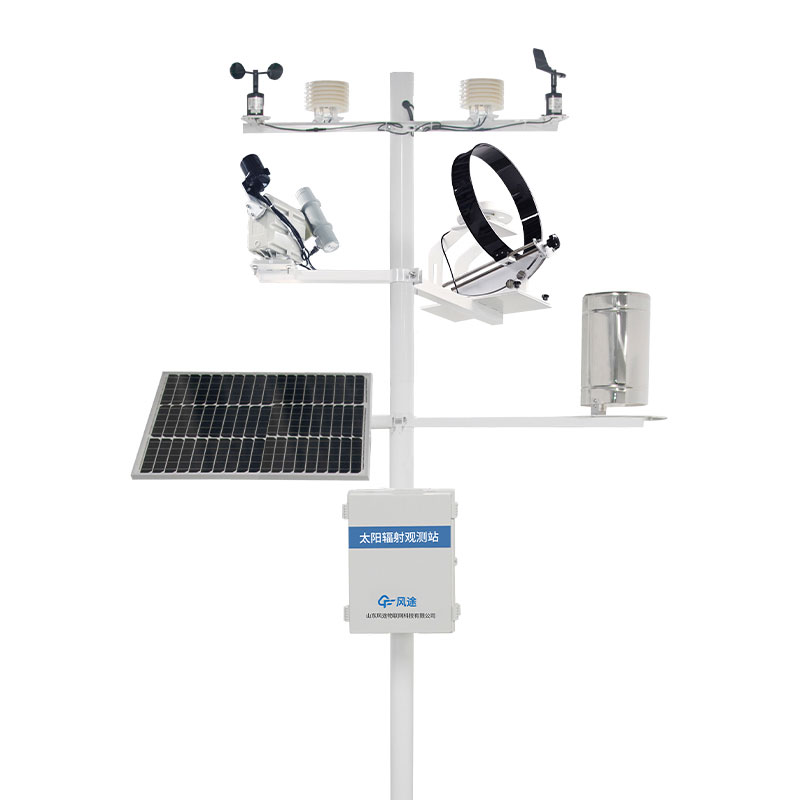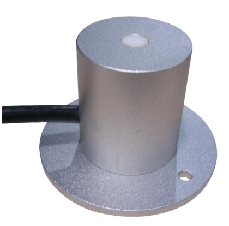Meteorological environment monitoring equipment supplier
Insist on doing high-precision customer favorite technology products

1.Overview of Solar Radiation Observation Station Products
The solar radiation observation station monitors the elemental information of the environment through sensors. Solar radiation is an important part of meteorological observation indicators. The solar radiation observation station transmits data to the cloud platform in real time, which is convenient for customers to view and statistically analyze. FT-TZ1 solar radiation observation station can measure various types of solar radiation energy data such as total solar radiation, diffuse radiation, direct radiation, reflected radiation, net radiation, ultraviolet radiation, spectral radiation, sub-spectral radiation and photosynthetically active radiation. , and the data can be transmitted to the cloud platform in real time, which is convenient for customers to view and statistical analysis.
The solar radiation observation station is mainly composed of six parts: collector, sensor, power supply system, display system, pole bracket, and cloud platform.
2. Product Features of Solar Radiation Observation Station
Power supply: DC12V
Output: RS485 MODBUS RTU protocol
Power supply mode: solar power supply/DC12V/AC220V/UPS
Baud rate: 4800—115200 Default baud rate: 9600
Working temperature: -30°C~+70°C
Storage temperature: -40°C~+80°C
Working humidity: 0~100%RH
Protection class: IP65
Communication mode: Wifi/GPRS/RS485/wireless point-to-point
Output aviation plug: IP68 SP13-6
Data receiving mode: wireless data cloud platform APP/PC/webpage wired stand-alone software secondary development communication interface
Bearing form: fixed bracket 3m
3. Sensor parameters of solar radiation observatory
simple total radiation | It is used to measure the total solar radiation in the spectral range of 0.3-3μm. If the sensing surface is placed downward, the reflected radiation can be measured, and the scattered radiation can also be measured by adding a shading ring. Spectral range: 0.3~3μm Measuring range: 0~1500W/m2 Power supply mode: DC 12V Output form: RS485 Response time: <45s Temperature related: <±0.08%℃ Cosine response: <±10% (when the sun altitude angle is 10°) Non-linearity: <±5% Annual rate of change: <±2% Working environment: Temperature -40℃~50℃ Humidity≤100%RH | |
TBQ total radiation | It is mainly used to measure the total solar radiation with a wavelength range of 0.3 to 3 microns. If it is placed horizontally downward, it can measure reflected radiation, and if it is added with a scattering shading ring, it can measure scattered radiation. It is composed of double-layer quartz glass cover, sensing element, shading plate, watch body, desiccant and other parts. The heart of the watch is the sensing element, which consists of a fast-responding wire-wound plated thermopile. The sensing surface is coated with 3M matte black paint. The sensing surface is a hot junction. When the sun shines, the temperature rises. It forms a thermoelectric potential with the cold junction on the other side, and the electromotive force is proportional to the intensity of solar radiation. Test range: 0~2000W/m2 Resolution 1W/㎡ Accuracy ±5% Sensitivity: 7~14μV/wm-2 Response time: ≤35 seconds (99%) Internal resistance: about 350Ω Spectral range: 0.3~3μm. Annual stability: ±2% internal resistance about 350Ω Cosine response: ≤±7% (when the sun altitude angle is 10°) Azimuth response error: ≤5% (when the sun altitude angle is 10°) Working environment temperature: -40℃~+50℃ | |
UV radiation sensor | The photoelectric detector is used to receive the ultraviolet light wave electric signal. This product is a precision instrument used to measure solar ultraviolet radiation (UVAB wavelength range) in the atmosphere Measuring range: 0~400mW/m2 Spectral range: 280~400nm Power supply mode: DC 5V/DC12V Output form: Voltage: 0-2.5V, RS485 Working environment: temperature -50℃~50℃ | |
Fully automatic direct radiation | The measurement of the radiation perpendicular to the surface of the sun (viewing angle about 0.5°) and the scattered radiation of the very narrow annular sky around the sun is called solar direct radiation, which is measured with a pyrheliometer. 1. Sensitivity: 7~14μV∕Wm-2 2. Time constant: ≤15S (99%); 3. Internal resistance: about 80 ohms; 4. Tracking accuracy: <168h±1°; 5. Opening angle: 4°; 6. Annual stability: ±1% (sensitivity change rate); 7. Working environment: -45℃~+45℃; 8. Power supply: DC12V; 9. Measuring range: 0~2000W/m2; 10. Signal output: 0~20mV; 11. Measurement accuracy: working table <5%; standard table <2%; 12. Power polarity: red + DC12V black 0
| |
scattered radiation | It consists of two parts, the pyranometer and the shading ring. The function of the shading ring is to ensure that the direct radiation of the sun can be continuously blocked from sunrise to sunset. The shading ring is composed of a shading ring, a ruler, a screw adjusting screw, a bracket, and a chassis. The shading ring has a width of 65mm and a diameter of 400mm, which is fixed on the screw adjustment screw of the scale, and the scale is engraved with latitude and declination scales. The ruler and bracket are fixed on the chassis and should be fixed according to the geographic latitude of the shooting site. Test range: 0~2000W/m2, resolution 1W/㎡, accuracy ±5% Sensitivity: 7~14μV/wm-2 Response time: ≤35 seconds (99%) Internal resistance: about 350Ω Spectral range: 0.3~3μm .Annual stability: ±2% Internal resistance about 350Ω Cosine response: ≤±7% (when the sun altitude angle is 10°) Azimuth response error: ≤5% (when the sun altitude angle is 10°) Working environment temperature: -40℃~ +50°C
| |
net radiation | The new net pyranometer is used to measure the net difference between the downward projection of the sky and the upward projection of the full-band radiance from the earth's surface. The measurement range is short-wave radiation from 0.3 to 3 microns and earth radiation from 3 to 50 microns. It is mainly used to study the state of the earth's heat budget, and can be applied to meteorological research, thermal stress and heat balance research, and highway road condition monitoring. The working principle of the watch is the thermoelectric effect. The sensing part is a thermopile composed of constantan wire with copper plating. The top of the thermopile is coated with 3M matte black paint. Two thermopiles receive solar radiation and earth radiation respectively. Due to the difference in radiation intensity absorbed by the upper and lower sensing surfaces, a temperature difference occurs at both ends of the thermopile, and its output electromotive force is proportional to the difference in radiation intensity received by the sensing surface. In order to prevent the influence of wind and rain on the output of the pyranometer and protect the sensing surface, the meter is equipped with a hemispherical special polyethylene film that can pass through both short-wave radiation (0.3-3 microns) and long-wave radiation (3-100 microns). cover. 1. Spectral range: 3~50μm (long wave radiation) 2.0.3~3μm (short wave radiation) 3. Measuring range: -300~+1000W/m2 4. Response time: ≤35 seconds (99%) 5. Internal resistance: about 350Ω 6. Year stability: ≤±2% 7. Consistency of sensing surface: ±15% 8. Temperature characteristic: ±2% (-20℃~+40℃) 9. Site diameter: Φ120mm 10. Length: 307mm 11. Polyethylene film cover: Φ33mm
| |
sunshine hours sensor | It is used to continuously measure the sunshine hours. When the direct radiation irradiated on the instrument is greater than a preset threshold, it will be automatically recorded by the collector as the sunshine hours. The instrument itself has no moving parts, low power consumption, and can be used for long-term observation in the field Count the presence or absence of sunshine every minute, and reset at zero every day. Measuring range: 0~24h Resolution: 0.1h Spectral range: 0.3~3μm Response time: <5s Cosine response: <±10% (when the sun altitude angle is 10°) Non-linearity: <±2% Annual rate of change: <±2% Power supply mode: DC5V Output form: RS485 Working environment: temperature -50℃~85℃, humidity ≤100%RH
| |
Photosynthetically Active Radiation Table | Also known as light quantum number, it is mainly used to measure the photosynthetically active radiation of natural light in the wavelength range of 400-700nm, and it is easy to use. It can be directly connected with a digital voltmeter or a data collector, and can be used under all-weather conditions. The watch uses a silicon photodetector and passes through a 400-700nm optical filter. When illuminated by light, a voltage signal proportional to the intensity of the incident radiation is generated, and its sensitivity is proportional to the cosine of the direct angle of the incident light Spectral range: 400~700nm Range: 0-2000 W/m2 Power supply mode: DC 5V Output form: Voltage: 0~2.5V/RS485 Response time: about 1s (99%) Temperature dependent: max. 0.05%/°C Cosine correction: up to 80° incident angle Operating temperature: -40° to 65° Relative humidity: 0~100% |  |